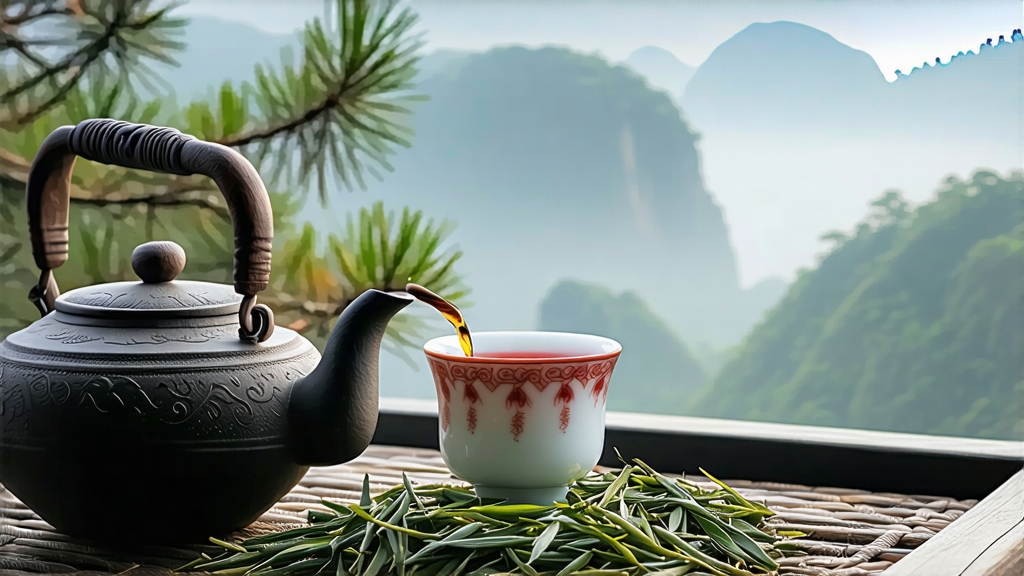
Long before Assam, Ceylon or Earl Grey ever existed, the first fully oxidised leaf that Europe would eventually call “black tea” was born in the rugged Wuyi massif of northern Fujian. Locals simply named it Zheng Shan Xiao Zhong—“Small Leaf from the Original Mountain”—but when Dutch traders carried the novel, ruddy liquor down the Min River and across the Indian Ocean in 1604, the international market baptised it Lapsang Souchong. The prefix “Lapsang” derives from the Fuzhou dialect lao san, “pine village”, while “Souchong” refers to the fourth and fifth leaves that pluckers once deemed too coarse for green-tea tribute yet perfect for the deeper, darker craft they were inventing. Thus a humble leaf meant for shepherds and monks became the prototype for every black tea on earth.
The Wuyi core zone, a UNESCO dual heritage of biodiversity and culture, is a labyrinth of 36 peaks, 99 valleys and a perpetual cloud-sea that shortens sunlight and intensifies amino acids. Here the indigenous Xiao Zhong cultivar—small, hardy, slow-growing—thrives on mineral-rich, weathered tuff soils. Two micro-climates matter most: the high, cool, misty “Zheng Shan” (original mountain) proper inside the 600–1 200 m belt, and the lower, warmer “Wa Shan” (outer mountain) foothills. Only leaves plucked inside the protected 600 km² park may legally claim the designation Zheng Shan; everything else is simply “smoked black tea”. Within the authentic zone, three traditional styles survive today: Classic Pine-Smoke, Modern Unsmoked, and the ultra-rare Wild Aged.
Classic Pine-Smoke is the original export recipe. Fresh leaves are withered over towering pine-log fires built in shallow pits lined with volcanic stone. The smoke is cool, 30–35 °C, dense with resinous terpenes that cling to the still-moist leaf. After 8–10 hours the leaf is rolled on rattan mats until the cell rupture rate reaches 85 %, then oxidised in oaken chests while smoke continues to drift through the cracks. Finally the tea is charcoal-baked for 90 seconds at 180 °C, locking in a tarry sweetness that will later bloom into longan fruit and pipe-tobacco notes. The entire cycle must finish before dawn so that morning dew does not re-hydrate the leaf and dull the crisp edge of smoke.
Modern Unsmoked, sometimes labelled “Zheng Shan Xiao Zhong Original Fragrance”, emerged in 2005 when German importers requested a cleaner cup for EU pesticide limits. Craftsmen dispense with the pine-fire, withering instead in electrically heated bamboo troughs at 28 °C, then oxidise in stainless-steel drums with humidified air. The leaf turns a sleek, ebony-black with flashes of molten gold; the liquor is a brilliant cinnabar, fragrant with caramelised malt, dried lychee and a whisper of Wuyi mineral that the Chinese summarise as “rock bone and floral heart”.
Wild Aged is the connoisseur’s secret. Once a year, pickers hike for three hours into the 1 400 m “Gua Dun” notch to collect leaves from tea trees that seeded themselves decades ago among the dwarf bamboo. The leaf is withered naturally in a bat-filled cave, rolled by foot, then pressed into 500 g bamboo cylinders and buried under pine needles for two years. Microbial fermentation softens the smoke and adds notes of dark chocolate, truffle and camphor. When unearthed, the cylinders are roasted over a gentle ember of cedar and longan wood, yielding a tea that tastes like a Burgundy barrel-aged in a Tibetan monastery.
To brew Lapsang Souchong gongfu style, begin with a 120 ml porcelain gaiwan or a thin-walled zisha pot that has previously seasoned only with light oolong; the clay’s porosity will round the sharper tar notes. Use 5 g of leaf—about two heaped teaspoons of the wiry, jet-black strands. Bring soft, neutral water to 95 °C; anything harder accentuates astringency. Rinse for three seconds and discard: this first flash awakens the leaf